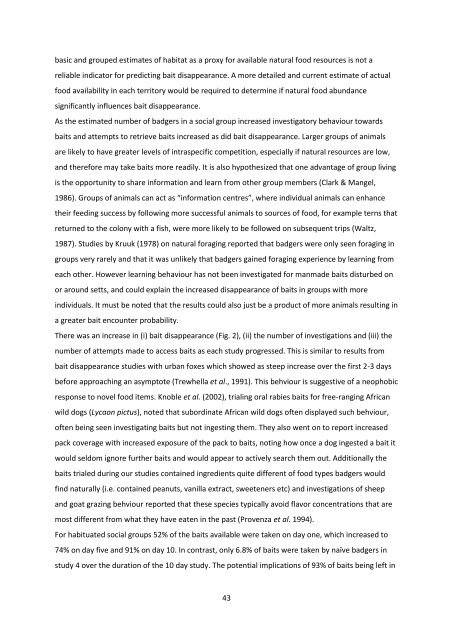Developing an oral bait for badger vaccination - Exeter Research ...
Developing an oral bait for badger vaccination - Exeter Research ...
Developing an oral bait for badger vaccination - Exeter Research ...
You also want an ePaper? Increase the reach of your titles
YUMPU automatically turns print PDFs into web optimized ePapers that Google loves.
asic <strong>an</strong>d grouped estimates of habitat as a proxy <strong>for</strong> available natural food resources is not a<br />
reliable indicator <strong>for</strong> predicting <strong>bait</strong> disappear<strong>an</strong>ce. A more detailed <strong>an</strong>d current estimate of actual<br />
food availability in each territory would be required to determine if natural food abund<strong>an</strong>ce<br />
signific<strong>an</strong>tly influences <strong>bait</strong> disappear<strong>an</strong>ce.<br />
As the estimated number of <strong>badger</strong>s in a social group increased investigatory behaviour towards<br />
<strong>bait</strong>s <strong>an</strong>d attempts to retrieve <strong>bait</strong>s increased as did <strong>bait</strong> disappear<strong>an</strong>ce. Larger groups of <strong>an</strong>imals<br />
are likely to have greater levels of intraspecific competition, especially if natural resources are low,<br />
<strong>an</strong>d there<strong>for</strong>e may take <strong>bait</strong>s more readily. It is also hypothesized that one adv<strong>an</strong>tage of group living<br />
is the opportunity to share in<strong>for</strong>mation <strong>an</strong>d learn from other group members (Clark & M<strong>an</strong>gel,<br />
1986). Groups of <strong>an</strong>imals c<strong>an</strong> act as “in<strong>for</strong>mation centres”, where individual <strong>an</strong>imals c<strong>an</strong> enh<strong>an</strong>ce<br />
their feeding success by following more successful <strong>an</strong>imals to sources of food, <strong>for</strong> example terns that<br />
returned to the colony with a fish, were more likely to be followed on subsequent trips (Waltz,<br />
1987). Studies by Kruuk (1978) on natural <strong>for</strong>aging reported that <strong>badger</strong>s were only seen <strong>for</strong>aging in<br />
groups very rarely <strong>an</strong>d that it was unlikely that <strong>badger</strong>s gained <strong>for</strong>aging experience by learning from<br />
each other. However learning behaviour has not been investigated <strong>for</strong> m<strong>an</strong>made <strong>bait</strong>s disturbed on<br />
or around setts, <strong>an</strong>d could explain the increased disappear<strong>an</strong>ce of <strong>bait</strong>s in groups with more<br />
individuals. It must be noted that the results could also just be a product of more <strong>an</strong>imals resulting in<br />
a greater <strong>bait</strong> encounter probability.<br />
There was <strong>an</strong> increase in (i) <strong>bait</strong> disappear<strong>an</strong>ce (Fig. 2), (ii) the number of investigations <strong>an</strong>d (iii) the<br />
number of attempts made to access <strong>bait</strong>s as each study progressed. This is similar to results from<br />
<strong>bait</strong> disappear<strong>an</strong>ce studies with urb<strong>an</strong> foxes which showed as steep increase over the first 2-3 days<br />
be<strong>for</strong>e approaching <strong>an</strong> asymptote (Trewhella et al., 1991). This behviour is suggestive of a neophobic<br />
response to novel food items. Knoble et al. (2002), trialing <strong>oral</strong> rabies <strong>bait</strong>s <strong>for</strong> free-r<strong>an</strong>ging Afric<strong>an</strong><br />
wild dogs (Lycaon pictus), noted that subordinate Afric<strong>an</strong> wild dogs often displayed such behviour,<br />
often being seen investigating <strong>bait</strong>s but not ingesting them. They also went on to report increased<br />
pack coverage with increased exposure of the pack to <strong>bait</strong>s, noting how once a dog ingested a <strong>bait</strong> it<br />
would seldom ignore further <strong>bait</strong>s <strong>an</strong>d would appear to actively search them out. Additionally the<br />
<strong>bait</strong>s trialed during our studies contained ingredients quite different of food types <strong>badger</strong>s would<br />
find naturally (i.e. contained pe<strong>an</strong>uts, v<strong>an</strong>illa extract, sweeteners etc) <strong>an</strong>d investigations of sheep<br />
<strong>an</strong>d goat grazing behviour reported that these species typically avoid flavor concentrations that are<br />
most different from what they have eaten in the past (Provenza et al. 1994).<br />
For habituated social groups 52% of the <strong>bait</strong>s available were taken on day one, which increased to<br />
74% on day five <strong>an</strong>d 91% on day 10. In contrast, only 6.8% of <strong>bait</strong>s were taken by naïve <strong>badger</strong>s in<br />
study 4 over the duration of the 10 day study. The potential implications of 93% of <strong>bait</strong>s being left in<br />
43
















